What Makes A Golf Course A Links Course
What Makes A Golf Course A Links Course? A links golf course is built near the coast on sandy soil and dunes. It has bumpy fairways, deep bunkers, and fast, firm greens. There are few trees, and the wind plays a big role in how you play.
The grass is usually fescue, and golfers use low, running shots. Links courses started in Scotland and are known for their natural look and tough conditions.
Why Golf Legends Loved Links Courses – What Makes a True Links Golf Course Special
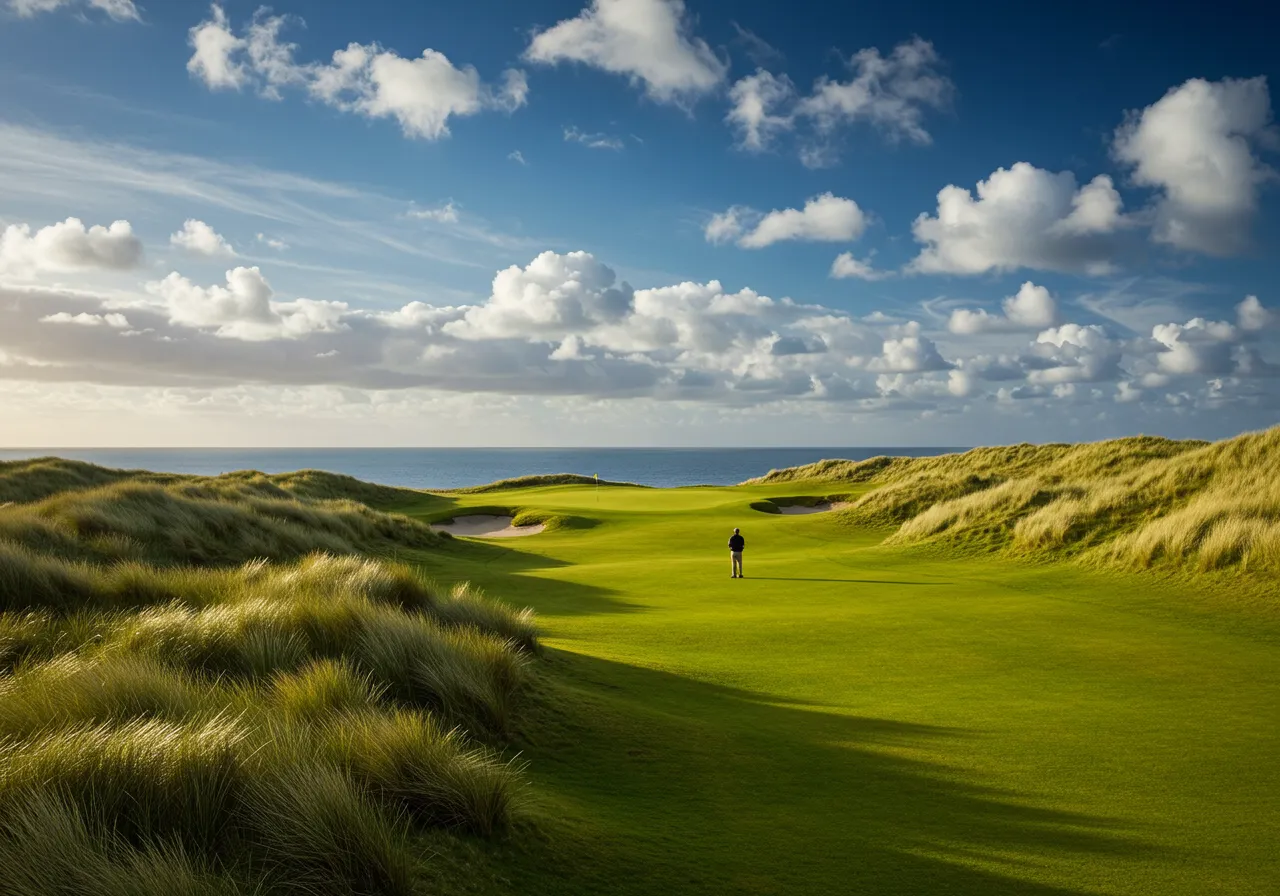
I’ve played golf all over the world, but nothing compares to walking onto a true links course. The ground feels different; it’s firm, the wind hits your face, and the grass is rougher, like fescue. It’s not just pretty; it challenges every part of your game.
You don’t just swing hard. You have to think: How will the wind carry my shot? Can I bounce the ball up instead of flying it high?
Old Tom Morris, one of the first golf greats, helped shape these courses over sand dunes near the sea in Scotland, where golf began.
He didn’t need bulldozers; he worked with the land. That’s what links golf is about. It’s real. It’s raw. It’s golf the way it was meant to be played.
And here’s a fun fact: out of over 30,000 courses worldwide, only about 250 are true links courses (according to R&A research).
That’s less than 1%! So if you ever get the chance to play one, know that you’re standing on golf’s original ground, where nature and skill meet.
What Exactly Makes a Golf Course a True Links Course
If you’ve ever heard golfers talk about “playing the links,” you might wonder what makes a golf course a real links course.
As a golf pro who’s walked those rugged fairways, I can tell you, it’s not just about being near the ocean. Links golf is about nature, challenge, and tradition. Let’s break it down.
What Geographic Features Define a Links Golf Course
True links golf courses are usually built along the coastline. These areas have sandy ground from old seabeds and are shaped by wind, not machines.
This sandy soil drains water quickly, so the course stays firm and dry. The land has natural dunes, big, rolling hills that make the fairways uneven.
These bumps and slopes are part of the game and force players to adjust every shot.
What Are the Natural and Ecological Traits of Links Golf
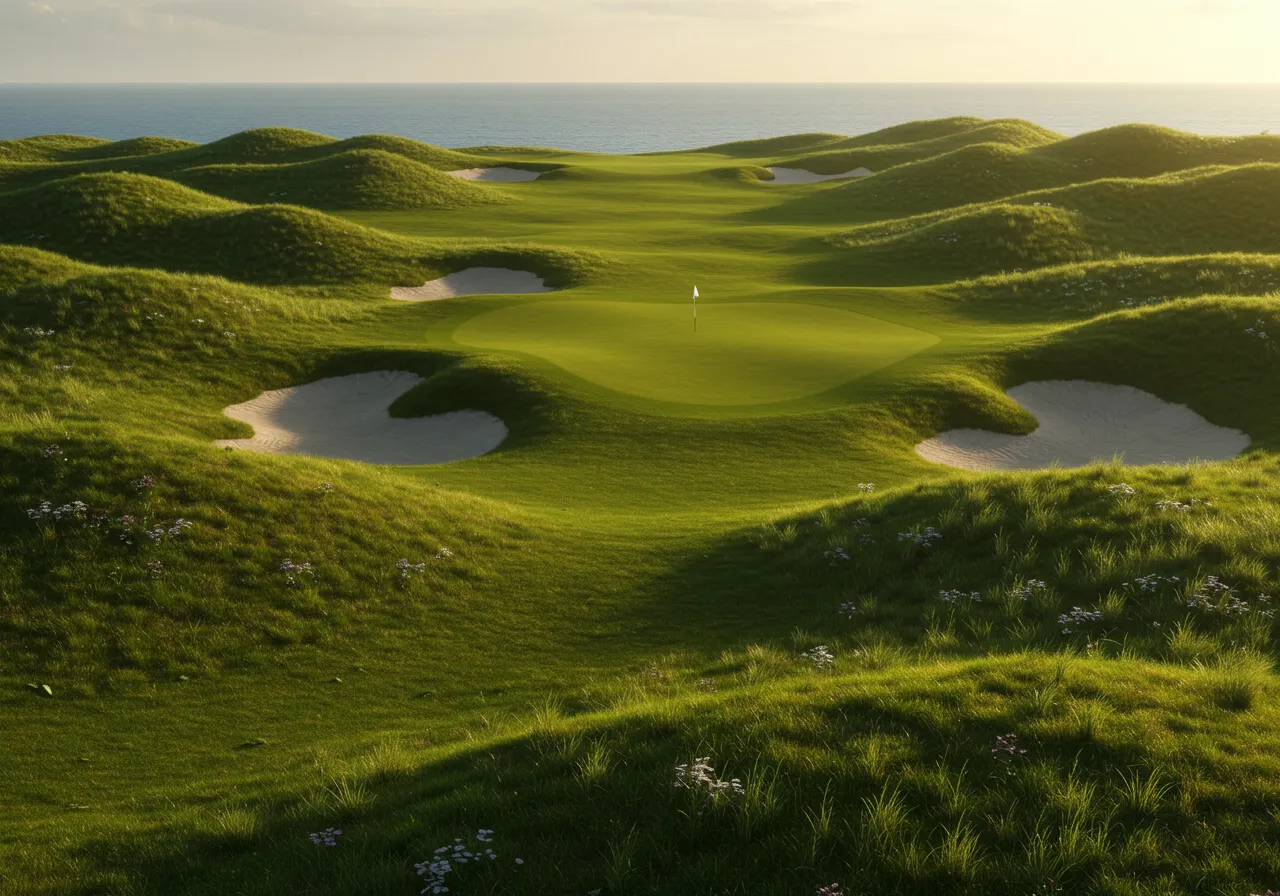
Links courses are not full of trees or soft green grass. Instead, they look wild and untamed. The grass is usually native, like fescue or marram, and grows in thick, rough patches.
The fairways are hard and fast, which means the ball rolls a lot after landing. Because there are very few trees, wind is a big factor.
You’ll see wide, open views of the sea, sky, and sand. Golfers have to hit smart, low shots that stay under the wind and roll up to the green.
Where Did Links Golf Courses Come From
The word “links” comes from an old Scottish word that means the land between the sea and the farms. This is where golf was first played over 500 years ago.
People used the natural land as it was, no tractors, no designs, just nature. The earliest courses were shaped by wind and weather, not by people.
That’s why links golf is still seen as the original and purest form of the game.
Why Links Golf Courses Are So Special
There are over 30,000 golf courses in the world, but fewer than 250 of them are true links courses. That’s less than one percent.
Playing a links course is like stepping into golf history. It’s harder than modern courses because of the wind, the tough grass, and the firm ground. But that’s what makes it so fun and so real.
What Is the Difference Between a Links Golf Course and a Regular Golf Course

As someone who’s played both links and parkland courses for years, I can tell you, they are completely different experiences.
It’s like comparing hiking on a rocky beach to walking through a quiet park. You use different shots, face different challenges, and even feel different when you play.
Let me break it down for you:
Real Differences Between Links and Parkland Golf Courses (From a Golfer’s Experience)
| Feature | Links Golf Course | Parkland (Regular) Golf Course |
| Terrain | Natural, bumpy dunes; no big machines used | Flat or gently rolling land, shaped by bulldozers |
| Soil | Sandy and dry; drains fast | Rich and soft; it stays wet longer |
| Hazards | Deep pot bunkers, tall fescue grass | Trees, water hazards, and out-of-bounds lines |
| Play Style | Low shots that roll a lot on firm fairways | High shots that stop quickly on soft greens |
| Weather | Wind is always part of the game | Wind matters less; trees often block it |
What Playing Each Course Feels Like
When I play a links course like St. Andrews in Scotland or Ballybunion in Ireland, I have to keep the ball low and let it bounce along the ground.
The wind is wild, the ground is hard, and the bunkers are deep. You don’t just hit hard, you have to think smart.
But on a parkland course like Augusta National or Wentworth, the grass is soft and smooth. I can hit high shots that land softly on the green.
It feels calm, with trees all around, and the wind usually isn’t a big deal.
The main difference between links and regular golf courses is that links golf is about adapting to nature, while parkland golf is about precision and control in a designed environment.
Both are fun, but if you want a real test of your creativity and toughness, links golf is where it all began.
What Are the Main Types of Golf Courses: A Golfer’s Guide to Every Style of Course

Over the years, I’ve played golf on just about every kind of course you can imagine. Each one feels different, from the way the grass rolls to how you plan your shots.
So if you’re wondering what the different types of golf courses are, let me walk you through the six big ones and what it’s like to play them.
Links Golf Course – The Original Style
This is where golf began, in places like St. Andrews in Scotland. Links courses are near the sea, with sandy soil, natural dunes, strong wind, and very few trees.
The ground is firm, so you play lots of low shots that bounce and roll. It’s tough, wild, and all about using your imagination.
Parkland Golf Course–Lush and Tree-Lined
Parkland courses are the kind you see on TV at big tournaments like The Masters at Augusta National.
These are inland courses, with soft grass, plenty of trees, and well-kept fairways. Here, you hit high shots that land softly. The air is still, and it feels calm and controlled.
Heathland Golf Course – Natural, But Not Coastal
Heathland courses are inland, like parkland, but with a sandier base and fewer trees. They feel more open and wild. Sunningdale in England is a good example.
These courses often use natural grasses and heather, and the play feels closer to links, but without the sea breeze.
Desert Golf Course – Dry and Dramatic
I’ve teed off in places like Scottsdale, Arizona, where the ground is dry, the sky is blue, and the cactus is your rough.
Desert courses are built in hot, dry areas and are watered to keep green. You have to hit straight, or your ball ends up in rocks or desert scrub.
Stadium Golf Course – Built for Big Crowds
These are made for tournaments and spectators, like TPC Sawgrass, home of the famous island green.
The design is bold, with big viewing areas, clear angles, and exciting holes. They feel like playing in a sports arena with a crowd, even when they’re alone.
Par-3 and Executive Golf Courses – Short and Fun
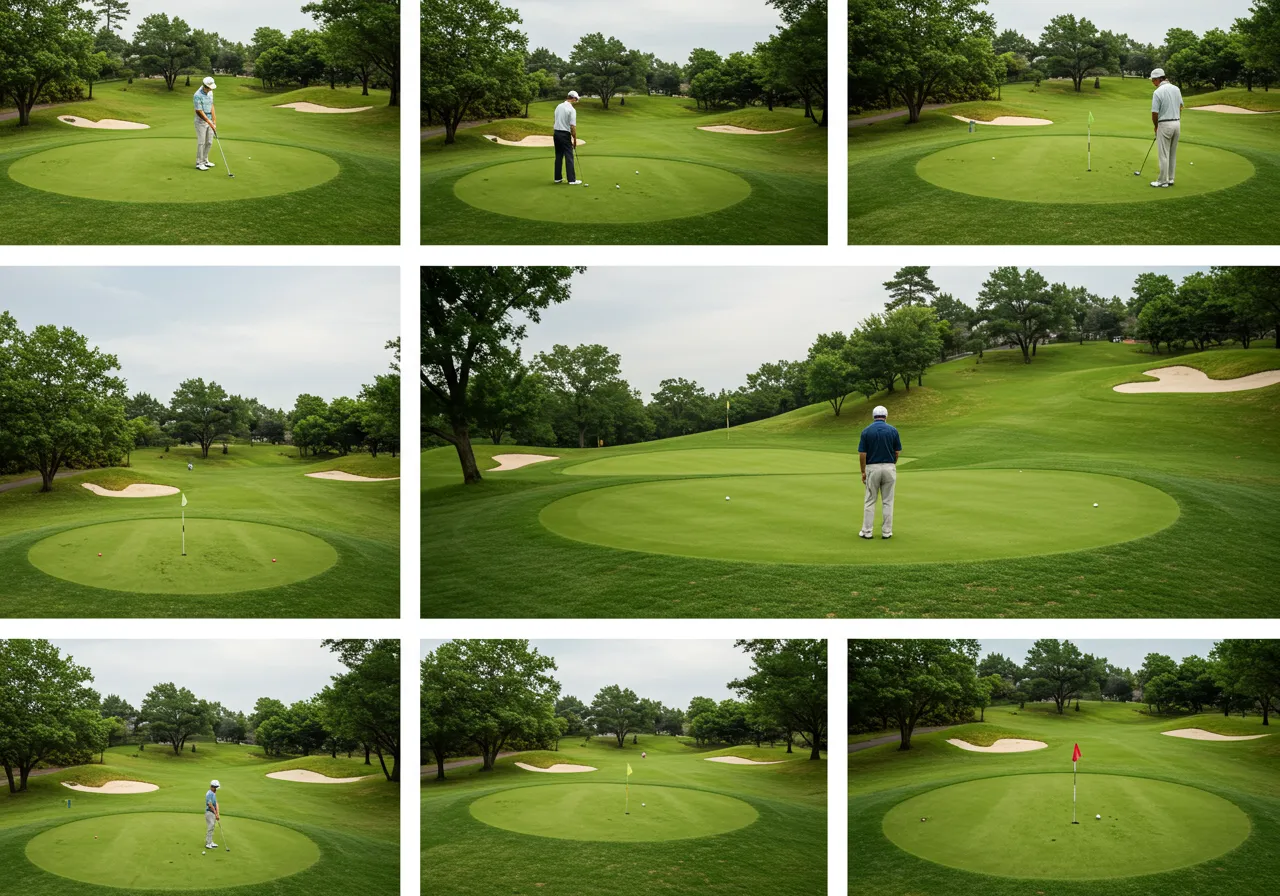
Sometimes you don’t have time for 18 long holes. That’s where Par-3 or executive courses come in.
These courses are shorter, often with only par-3 holes or a mix of shorter holes. They’re perfect for beginners, practice, or quick rounds. You’ll still need skill, but not every shot needs to fly 300 yards.
No matter where you play, on a sandy links, under desert sun, or beneath the trees in a quiet parkland, every type of golf course teaches you something new.
That’s what makes golf so fun. It’s not just the swing. It’s the course.
Comparison Table: 6 Types of Golf Courses and Their Key Traits
| Course Type | Location | Terrain & Soil | Grass & Features | Common Hazards | Play Style & Feel | Example Courses |
| Links | Coastal (near sea) | Sandy dunes, firm, natural | Fescue, marram, native grass | Deep pot bunkers, wind | Low shots, ground game | St. Andrews (Scotland), Ballybunion |
| Parkland | Inland | Lush, landscaped, soft soil | Bentgrass, ryegrass | Trees, water, and bunkers | High shots, soft landings | Augusta National, Wentworth |
| Heathland | Inland, open | Sandy with Heather, rolling | Mix of native and fairway grass | Gorse, heather, rough | Control shots, blend of link/parkland | Sunningdale (England) |
| Desert | Arid/dry regions | Rocky or sandy, dry terrain | Bermuda, desert-adapted grass | Rocks, cacti, and sand waste | Precision shots, target-focused | Scottsdale (Arizona), Abu Dhabi |
| Stadium | Tournament venues | Built for viewing, dramatic | Tournament-ready fairways | Water, bunkers, dramatic greens | Strategic, crowd-focused, high-pressure | TPC Sawgrass (USA) |
| Par-3/Executive | Anywhere | Compact, flat to mild slope | Short-cut grass, maintained | Few hazards, simpler setup | Short game, beginner-friendly | Local city courses, practice clubs |
Note: This table highlights the main differences between the six types of golf courses. Each has its own design, feel, and strategy.
Why Is Links Golf So Hard to Play Compared to Regular Golf Courses
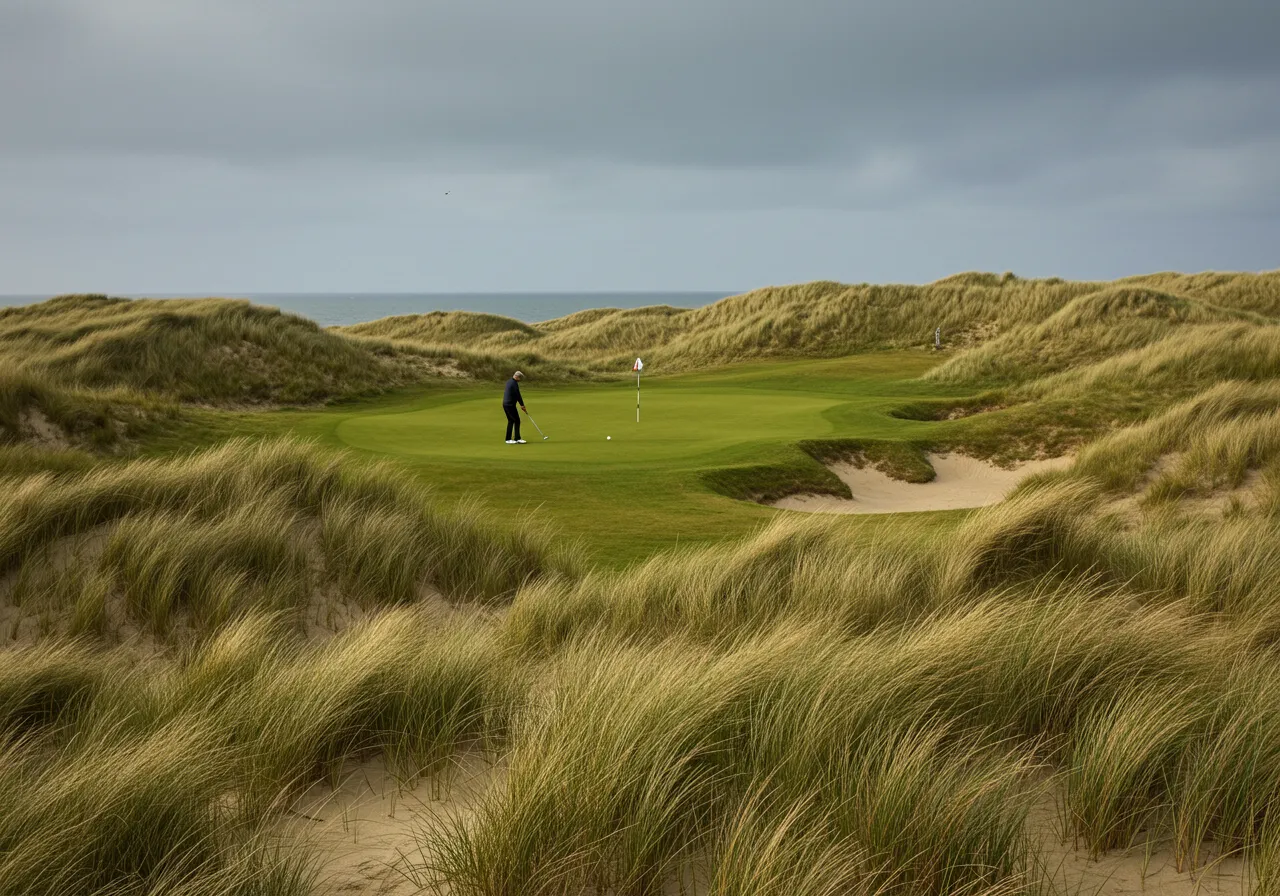
If you’ve ever played a true links golf course, you know right away, it’s not like a regular parkland course. The wind is stronger, the ground is firmer, and the course is more unpredictable.
As a golf pro, I’ve had rounds where I used almost every club in the bag just to keep the ball under control. Let me show you why links golf is considered the ultimate test.
Why Does Wind Make Links Golf Courses So Difficult
Links courses are usually built next to the sea, where the wind blows hard and often. It can move your ball left or right, or knock it down early.
Even a perfect swing can go wrong if the wind shifts during your shot.
That’s why we use low-trajectory shots, like a punch shot, to keep the ball under the wind. On a links course, judging the wind is as important as picking the right club.
How Firm Turf and Fast Roll Make Shot Control Harder on Links Courses
The ground on a links course is made from sandy soil, which drains water quickly. This creates hard, fast fairways. The ball doesn’t just land, it bounces and rolls far.
That means if you aim at the flag directly, you might roll way past the green.
You have to aim short, use the ground, and plan for natural roll. That’s why ground game strategy is so important on links turf.
What Are Blind Shots in Links Golf and Why Are They So Tough
Unlike regular courses, links courses often have rolling dunes and uneven land. This means you can’t always see where your ball will land. These are called blind shots. You might be heading toward a flag you can’t even see.
It’s scary at first, but with experience, you learn to trust landmarks, yardage markers, or memory. These shots make links golf feel like a puzzle you solve step by step.
Why Links Golf Demands More Mental Focus Than Parkland Golf
Links golf is a mental game as much as a physical one. The conditions change fast: wind gusts, strange bounces, and rough terrain test your patience.
You can’t just hit the ball and hope. You have to think through each shot. As one Reddit golfer said: “Play the course, not the scorecard.” That means focus on doing your best on each shot, even when things don’t go perfectly.
What’s the Best Short Game Strategy on a True Links Course

Here’s one of the biggest changes in your short game: on a links course, use your putter from off the green, even from 30 or 50 yards out.
That’s because the turf is so firm and smooth that the ball will roll better than if you chip it.
This works especially well when the wind is strong, because a low rolling putt stays on target better than a high chip that can get blown off line.
Are All Coastal Golf Courses Really Links Courses
As a golf pro who’s played true links courses in Scotland and modern seaside courses in the U.S., I can tell you that’s not true at all.
What Makes a Golf Course a True Links Course and Not Just Coastal
Just because a course is near the water doesn’t mean it’s a links course. To be a real links, the course needs more than just ocean views.
It must be built on sandy soil, have natural dunes, and be shaped by the wind and terrain, not machines.
A good example is Pebble Beach in California. It’s beautiful, it’s by the sea, and it’s world-famous. But it’s not a true links course.
Why? Because its soil is not sandy, and its layout is designed more like a parkland course, with trees and shaped fairways. It’s often called “link-style,” but that’s not the same.
What’s the Difference Between a True Links Course and a Links-Style Course
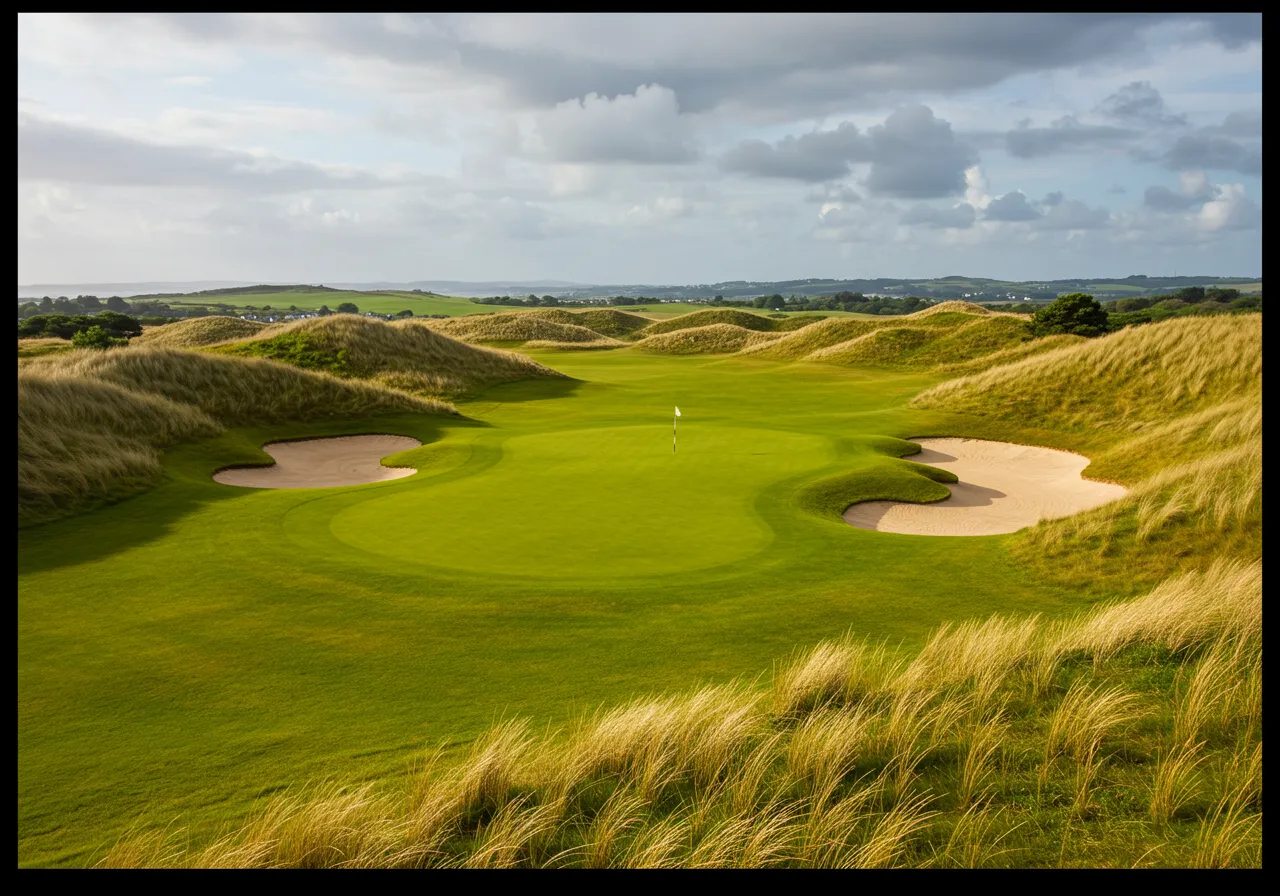
A true links course is found on land between the sea and farmland, usually on old coastal dunes with poor soil, the kind you couldn’t grow crops on.
That land drains quickly, is firm underfoot, and is shaped naturally. That’s what you see at St. Andrews or Royal Troon in Scotland.
A links-style course, on the other hand, might look like a links (few trees, some rolling hills), but it’s often built inland, with engineered bunkers, irrigation, and soft turf. It may feel like a link, but it doesn’t play like one.
When I visit a course and someone says, “It’s links-style,” I ask one thing:
“What’s the turf like?”
If the ground is firm, the ball bounces, and the wind shapes your game, it might be a true links. If it’s soft, wet, and shaped like a garden, it’s probably not.
Why Are Golf Courses Called “Links”
When people first hear the word “links,” they often think it just means any golf course.
But as someone who’s walked the oldest golf grounds in Scotland, I can tell you, “links” means something very special in golf history.
What Does the Word “Links” Actually Mean in Golf
The word “links” comes from an old Scottish word, hlinc, which meant rising ground or ridge.
In Scotland, that word described a specific type of land: the coastal strip between the sea and the farmland. This land was sandy, windy, and full of dunes. You couldn’t grow crops there, but it was perfect for golf.
This is the land where golf was first played, back in the 1400s. In fact, one of the first written records of the sport comes from Edinburgh in 1457, where the king banned people from playing “golf on the links” because they weren’t practicing archery. That’s how far back this goes.
Why the Name “Links” Still Matters Today in Golf
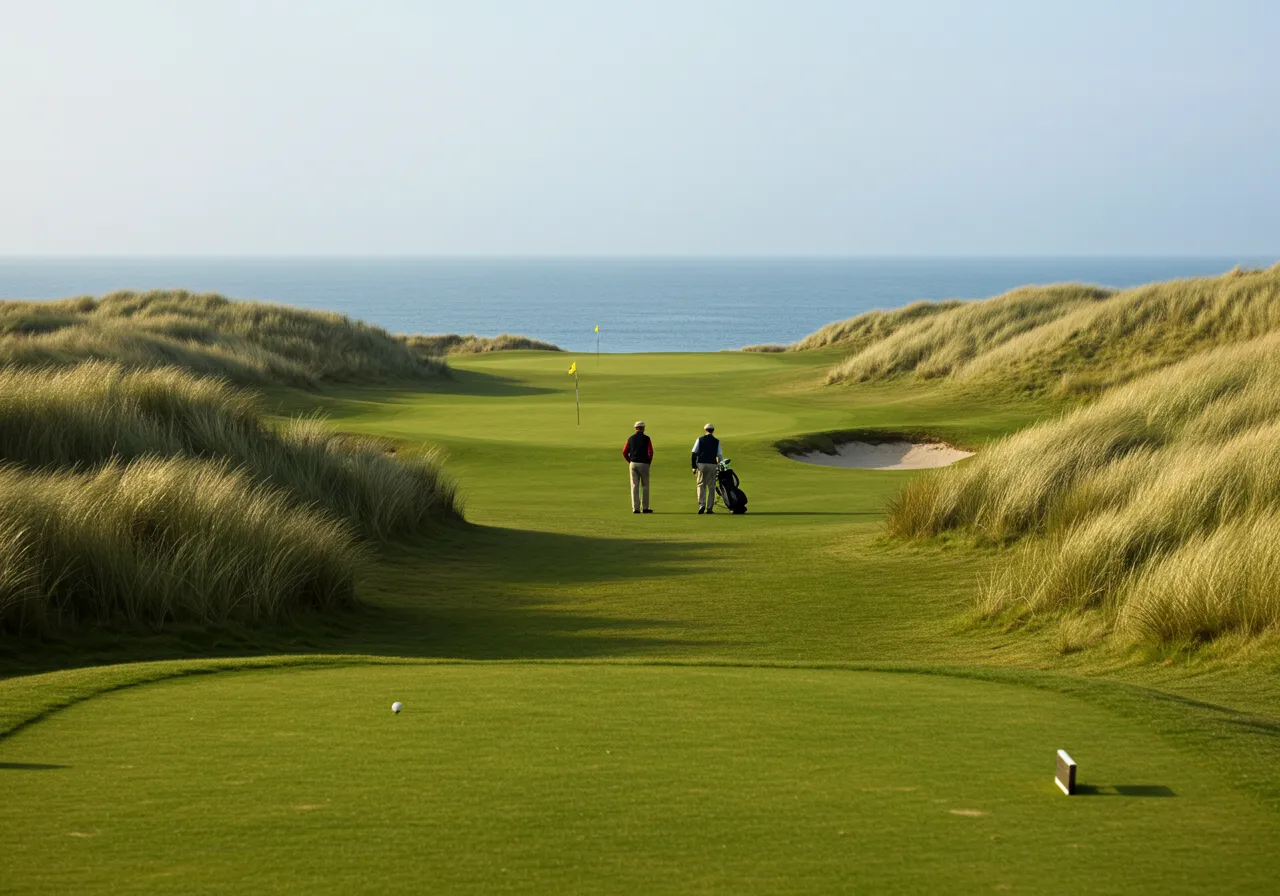
When you hear “links course,” it doesn’t just mean “golf by the sea.”
It means a course built on natural, coastal terrain, with firm, sandy soil and rolling hills shaped by wind, not machines. These courses are still found mostly in places like Scotland, Ireland, and England.
So, when I play on a true links course, like St. Andrews, I know I’m not just playing golf. I’m walking on the same ground where golf was born.
Table: Origin and Meaning of the Term “Links” in Golf
| Feature | Explanation |
| Word Origin | From the Old Scots word “hlinc,” meaning rising ground or ridge |
| Geographic Meaning | Describes the coastal land between the beach and the farmland in Scotland |
| Soil Type | Sandy, firm, poor for farming, but perfect for golf |
| Landscape Traits | Natural dunes, windy, few trees, rolling terrain |
| First Historical Use | 1457 – King of Scotland banned “golfe be playit on the links” |
| Why It Matters in Golf | This land became the birthplace of golf, and true links courses today |
Note: This table shows that “links” is not just a golf term, but a word rooted in Scottish geography and history.
How Can You Find a True Links Golf Course Near You
Lots of golfers ask me, “Where can I find a real links course to play?”
As someone who’s played on the windswept shores of Scotland and the sandy dunes of Australia, I can tell you, not every seaside course is a true links, but you can find them if you know where to look.
Use the Official True Links List to Find Verified Links Golf Courses
The best place to start is the R&A’s official “True Links” list. These courses are inspected and confirmed to meet all the real links standards:
- Sandy soil
- Coastal dunes
- Natural design with firm ground
Some famous ones on that list include:
- St. Andrews (Scotland)
- Royal Dornoch (Scotland)
- Royal County Down (Northern Ireland)
- Royal Melbourne (Australia)
Use Google Earth or Golf Apps to Spot Links-Style Terrain
If you’re not in the UK or Australia, you can still try this pro tip:
Go on Google Earth and look at coastal areas with natural dunes and no trees. These are signs of a potential links-style layout.
You can also check apps like GolfNow, TheGrint, or GolfPass and filter by course style, region, or ratings. Some even include user comments like “plays like a true links.”
Budget Tip: Play Links Courses in the Shoulder Seasons
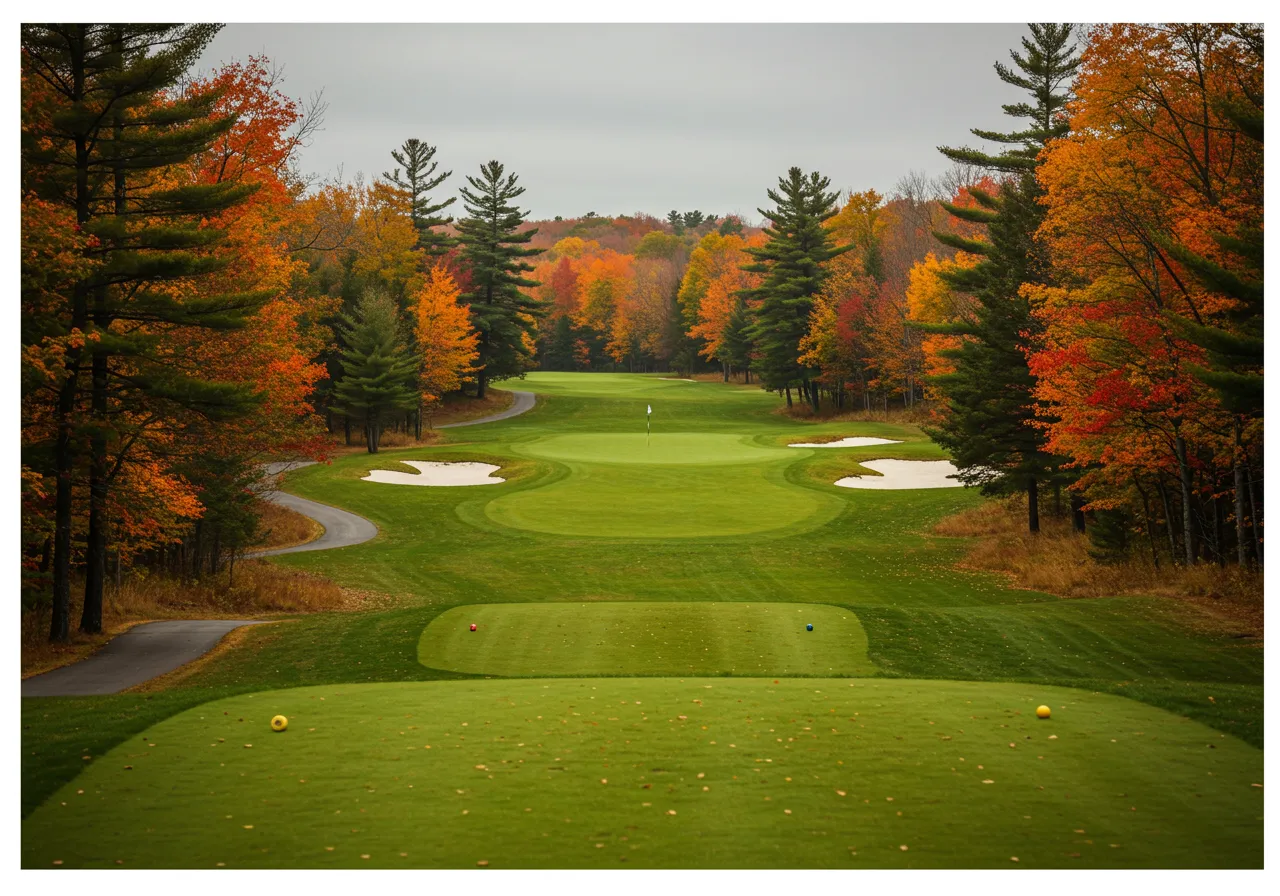
If you’re on a budget, try playing before summer or just after, what we call the shoulder season.
Rates drop, the wind is still there (so it plays like a true links), and the crowds are smaller. I’ve played Royal Dornoch in April and had the course nearly to myself, for half the summer price.
Advice From a Pro: Don’t Just Look for the Sea, Look for the Soil
Coastal views are great, but a true links course is about the land:
- Firm fairways
- Rolling dunes
- Wind in your face
- A ball that rolls forever
So if you’re searching for a “links golf course near me,” focus on terrain, not just location. That’s where the magic really begins.
FAQs
What is the hardest links golf course in the world?
Carnoustie in Scotland is often called the hardest. It has deep bunkers, tight fairways, and strong winds. Royal County Down in Northern Ireland is also very tough because of blind shots and gorse bushes.
Do you need different golf clubs for links golf?
Yes. Use lower-lofted irons and hybrids to hit low shots into the wind. Avoid high-spin golf balls, as they fly too high and can get pushed by the wind.
What does TPC mean in golf?
TPC stands for Tournament Players Club. These are PGA Tour courses, built for stadium-style events, not natural links play.
How much does it cost to join a links golf course?
Public links courses can cost as little as $50 to $200 per year. Private links clubs can charge $50,000 to over $100,000, plus yearly fees.
Conclusion
After all these years, and all the courses I’ve played around the world, I still believe that true links golf is the game in its purest form.
On a links course, it’s not just about swing speed or perfect technique. It’s about understanding the land, reading the wind, and trusting how the ball will bounce on firm, natural ground. Every shot is a new challenge.
Sometimes, you’ll need to putt from 40 yards. Other times, you’ll punch a low iron into a crosswind. That’s links golf.
You’re not just playing a course. You’re having a conversation with nature, a back-and-forth between you, the wind, the turf, and the terrain.
If you’ve never played a links course before, it’s time. If it’s a famous coastal course or a small public links-style layout, the challenge is real, and so is the fun.